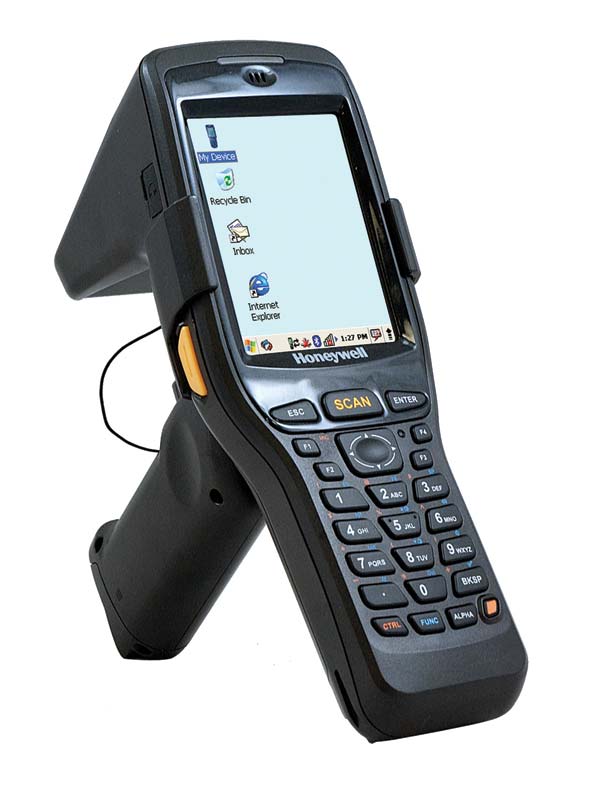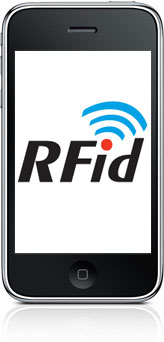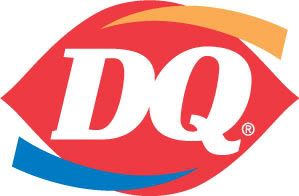Honeywell Announces the New Optimus 5900 RFID Mobile Computer
 The New Optimus 5900 RFID Mobile Computer
The New Optimus 5900 RFID Mobile Computer
The Optimus 5900 RFID is a versatile, light industrial mobile computer designed to deliver the benefits of radio frequency identification (RFID) and automated data collection for retail and supply chain enterprises. Providing quick and accurate reading of EPC Gen2 and ISO 18000-6B RFID tags, the Optimus 5900 RFID improves visibility of item-level inventory, helping retailers reduce item out of stocks and merchandise shrink, leading to increased sales and reduced operating costs. The benefits of RFID-based inventory management also extend to warehousing and distribution operations, offering fast and accurate tracking of products from delivery to point of sale.
The lightweight yet rugged mobile computer features an ergonomic form factor for ease of use over an extended period of time and comes complete with a crisp 3.5-inch screen, resistive touch panel and 28-key keyboard for accurate data entry. Integrated Adaptus Imaging Technology 5.0 provides advanced image-based data capture capabilities, allowing workers to perform all inventory management and mobile computing tasks on a single device.
Intermec Advanced RFID Extensions (ARX)
Intermec introduces the first tag motion software toolkit in a standardized reporting format. Intermec Advanced RFID Extensions (ARX) effectively identifies RFID tags of interest and discriminates surrounding tags, providing customers and software integrators the tools to essentially eliminate false-positive reporting of tags.
Getting the Most out of RFID
RFID provides business benefits and a strong ROI for many applications including asset tracking, materials management, and inventory control. Many processes for identifying objects and recording their movements can be automated by RFID. Unattended readers ensure that asset and inventory movements are recorded and alerts issued if the material is moved to the wrong place or at the wrong time. With a well designed RFID system you know all the intimate details of where everything is, where it’s been and where it needs to go. By making your systems smarter, you will be able to:
- Realize huge improvements in asset and inventory visibility
- Resolve problems right when they occur
- Reduce capital and operations expenses
- Increase flexibility of your data collection systems
- Achieve new levels of productivity
RFID automated processes rely on the accuracy of reading the right tags: those that pass through a portal, are on a forklift, or are passing by a checkpoint on a conveyor. Because an RFID reader indiscriminately reads all of the tags that it activates, the presence of stray tags, such as those that pass through a nearby portal or are stationary on nearby racks or pallets, complicates the identification of the true tags of interest versus those that are not part of the process in action.
Continue reading »
New RFID Tag Designed for Jewelry Items
Inventory management researchers recently unveiled a new RFID tagging system that will enable consumers and businesses to track valuable jewelry.
The new tags were created to attach to jewelry items such as necklaces and earrings, allowing individuals to monitor and follow their possessions in real time. Each RFID unit features a small hole, in which the piece of jewelry can easily slide into, therefore mitigating any damage to the accessory.
If a consumer or jewelry store owner accidentally misplaces an expensive pearl necklace or pair of diamond earrings, they can use the new tags – which can be identified within a range of three feet – to find them.
The tag’s slim and light-weight design allow it go unnoticed, while still maintaining a high level of protection.
RFID tags are used commonly in warehouses and retail sectors to increase oversight over supplies and to improve tracking capabilities. Other industries have recently adopted the technology, as the benefits can help a company save money by not having to invest in items because they have mistakenly been misplaced.
RFID Improves Inventory Visibility
Handheld RFID readers are 90 percent faster than using barcode scanning guns for taking inventory.
Drivers whose windshields get too dusty don’t hesitate to clean the glass and improve their view. So why are retailers content to operate their businesses for months at a time with hazy information about their true in-stock positions?
Many executives assume that this is the best that can be done. After all, full inventory audits are costly and cumbersome. And retail shrink, cashier error and hard-to-detect shipment discrepancies are chronic problems that show little sign of abating. What these executives don’t realize is that a solution exists today that can give them clear visibility 365 days a year.
The solution that is creating this step change in visibility is called RFID, short for Radio Frequency Identification. Employees who use handheld RFID readers are able to take inventory over 90 percent faster than counterparts using traditional barcode scanning guns, and with greater accuracy, too.
New Apple patent could put an RFID reader in every pocket
 The United States Patent and Trademark office has just published a patent from Apple, Inc. (filed December 27, 2007) for “An apparatus for providing radio frequency identification (RFID) and touch sensing capability”
The United States Patent and Trademark office has just published a patent from Apple, Inc. (filed December 27, 2007) for “An apparatus for providing radio frequency identification (RFID) and touch sensing capability”
This could show up in Apple products in a number of ways, but one side effect could be to add RFID reading capability to the iPhone. In the same way the camera integrated into the iPhone allows rudimentary barcode scanning capability, an RFID chip inside the next iPhone could turn it into a basic RFID reader.
RFID Has Role Protecting Human Health

Coupled with collaborative technology, RFID can help manage efficient responses such as the recall of suspected food products and notifying affected parties. For example, a calf can now be tracked from birth to the slaughterhouse as it is in Australia, where the National Livestock Identification System legislation mandated, in 2005, RFID tagging for cattle stock.
There are even pilots where, combined with global positioning system (GPS) and “shock” technology, farmers can manage RFID-tagged cattle within certain geographical boundaries.
Let’s envision how RFID and collaborative technology can work together to help assure the quality of pork humans consume.
Cost Still a Hurdle for RFID

According to a survey conducted by Australia-based University of Wollongong’s Centre for Business Services Science, one reason companies adopt radio-frequency identification technologies is to gain an advantage over their rivals, and another is improved data accuracy. Companies that have not adopted RFID, however, cite the technology’s cost as one of the most important factors influencing their decision.
(Original article: http://www.smartbrief.com/news/comptia/storyDetails.jsp?issueid=6BBCD91D-F82A-4F8E-A30B-79D6476F5235©id=D42F4495-2E52-4B17-B810-DB06651E6965)
Dairy Queen Tests RFID Mobile Marketing Solution

Tetherball, an industry leader in mobile loyalty and rewards solutions, has unveiled its breakthrough RFID-based mobile marketing platform and a test with International Dairy Queen.
According to CBS News, the test is being conducted at a single Dairy Queen store in Rochester, Ind. The solution tracks customers’ purchases and makes are make customized coupon recommendations upon their entering the store.
“We are a big believer in the future of mobile marketing,” said Jamie Guse, Web site manager for International Dairy Queen Inc. “Through (Tetherball’s) innovative RFID-based Mobile Loyalty Program, we are able to provide great offers to our customers in a fun and easy way while precisely measuring the effectiveness of our Dairy Queen Mobile Rewards Program.”
International Dairy Queen Franchisee Dave Reasner has been working with Tetherball for nearly two years to refine the mobile loyalty program for his stores. The program now averages more than 900 members per store, with continued solid growth in membership and redemption rates. The solution is “making a measurable difference in our year-over-year traffic and revenue,” he said.
Will RFID Lead to Near-field Communications (NFC)?
![rfid-tag[1]](https://www.barcodesinc.com/news/wp-content/uploads/2009/06/rfid-tag1.jpg) Mobile banking and payments is considered a promising area, in which near-field communications (NFC) is widely viewed as the pinnacle. NFC promises to turn the mobile phone into a secure credit card by enabling the exchange of data between devices over about four inches of distance. While companies work out the kinks to make it attractive for all members of the ecosystem, including carriers, radio frequency identification (RFID) tags that can be affixed to the mobile phone are cropping up as a temporary solution – one that Aite Group senior analyst Nick Holland says is extremely flawed.
Mobile banking and payments is considered a promising area, in which near-field communications (NFC) is widely viewed as the pinnacle. NFC promises to turn the mobile phone into a secure credit card by enabling the exchange of data between devices over about four inches of distance. While companies work out the kinks to make it attractive for all members of the ecosystem, including carriers, radio frequency identification (RFID) tags that can be affixed to the mobile phone are cropping up as a temporary solution – one that Aite Group senior analyst Nick Holland says is extremely flawed.
“This is seen by the people who put the stickers out as some interim technology that will magically get us to NFC, whereas what is really required is a solid business case for NFC and a level of merchant penetration for contactless payments that makes NFC viable,†Holland said. “This, as far as I’m concerned, is a step in the wrong direction. This is not something that will accelerate NFC. If anything, it’s going to be a distraction.â€
Companies including Blaze Mobile, MasterCard, First Data and, as of today, Alcatel-Lucent and Tetherball, are among those using RFID stickers to bridge the gap to NFC. Alcatel-Lucent (NYSE: ALU) announced today its touchatag venture will work with Belgacom mobile and micro payments company PingPing, to create an open model of application development for contactless cards and mobile payments. Through the partnership, Belgian consumers can use one contactless card or sticker to launch mobile payments or other mobile applications.
Debunking Reports of RFID’s Death
![rfid-tag[1]](https://www.barcodesinc.com/news/wp-content/uploads/2009/06/rfid-tag1.jpg) Given some of the negative news this year related to the use of radio frequency identification, as well as the decline in capital spending by most businesses, some had predicted the industry might have suffered a devastating blow from which it could not recover. I doubt anyone who attended last week’s RFID Journal LIVE! event in Orlando, Fla., would reach that conclusion today.
Given some of the negative news this year related to the use of radio frequency identification, as well as the decline in capital spending by most businesses, some had predicted the industry might have suffered a devastating blow from which it could not recover. I doubt anyone who attended last week’s RFID Journal LIVE! event in Orlando, Fla., would reach that conclusion today.
Our seventh annual conference and exhibition attracted 2,400 people, which was down a bit from last year’s total of a little more than 3,000. But many people, including exhibitors, feared attendance would be a lot lower, given that many trade shows have been down 50 percent or more due to the challenging economic conditions. They were pleased to see the aisles filled, but they were absolutely thrilled as they engaged in conversations with attendees. Most end users at the event were focused on specific projects with budgets and timelines. They are investing in RFID technology.
Last week, I said I thought RFID had crossed the chasm (see RFID Crosses the Chasm), and LIVE! 2009 confirmed that to be true. Those who attended this year were not visionaries dreaming about how RFID would one day transform the global supply chain. They were businesspeople from a wide range of industries and countries, seeking solutions to common business problems—lost and misplaced assets, inventory inaccuracy, shipping and receiving problems, and so forth.
I spoke to several end users during the free consultations we offered at the event. All had a solid understanding of RFID, and knew it could help them. They sought insights regarding which solution would be best, and wanted to know which vendors they should talk to.
Most applications being considered by attendees were closed-loop. That’s not surprising. Many companies have issues stretching across the supply chain, but it makes sense to tackle issues within their own control. They also seek solutions that can deliver a fast return on investment. Still, these early deployments will lead to additional projects down the road. At a private lunch hosted by ADT, one gentleman told me, “I got all the information I need to move ahead with my project, but I got five or six other ideas of how RFID could really help us.”
The attendees with whom I spoke impressed with the quality of the RFID products being exhibited. Hardware and software products are getting less expensive and easier to deploy. Motorola’s new reader is a case in point—it’s half the size and cost of its predecessor, but also has some great new features, such as built-in indicator lights and power-over-Ethernet, so you don’t have to run power cables to every location in which you want to place a reader.
ODIN Technologies, winner of our second Best in Show award at this year’s RFID Journal Awards ceremony (see Voegele, Vail, FOCUS and ODIN Technologies Win RFID Journal Awards), introduced a very cool self-contained, mobile RFID portal that can be installed in any ISO-standard shipping container in less than a minute. The unit comes with magnets enabling it to be popped into place, and also offers Wi-Fi, cellular and satellite communications capabilities to transmit the RFID data it captures.
In some ways, I think this event was critical to the RFID industry’s continued growth. The business that exhibitors get from attendees will enable them to continue investing in new products and services; without that continued innovation, the industry would stagnate. Next year, I predict that we’ll see even more attendees ready to invest, and I’m sure we’ll also see exhibitors with new, innovative products.
(Original article: http://www.rfidjournal.com/article/view/4841)




